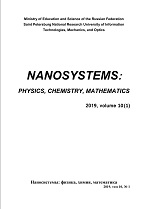|
FROM GUEST EDITORIAL
Catalytic pyrene and pyrene butyric acid condensation as a means of producing graphene
O. A. Shinkarenkoab, M. V. Pozharovc, A. S. Kolesnikovab, A. S. Chumakovab, A. J. K. Al-Alwanid, O. Yu. Tsvetkovab, E. G. Glukhovskoyab
a Department of Nano- and
Biomedical Technologies, Saratov State University, Saratov, Russia
b Education and Research Institute of Nanostructures and Biosystems,
Saratov State University, Saratov, Russia
c Institute of Chemistry, Saratov State University, Saratov, Russia
d Babylon University, Babylon, Iraq
Abstract:
In the present study, we have conducted molecular modeling of a potential method of graphene sheet formation. As the nano-sized blocks from which graphene can be synthesized, pyrene and pyrene butyric acid are chosen. The potential of several compounds (namely, Pt, Pd, Ni, AlCl$_3$ and PdCl$_4$) as catalysts for hydrocarbon condensation has been estimated by semiempirical calculations. The heat of formation in the series Pt, Pd, Ni, PdCl$_4$, AlCl$_3$ for pyrene is reduced to a minimum and reaches a value of 99 kJ/mol, and for pyrene butyric acid in the series Pt, Ni, Pd, PdCl$_4$, AlCl$_3$ decreases to 295 kJ/mol. According to the results of calculations, Pt and Ni can be the most effective catalysts for this reaction. As a substrate (or 2D nanoscale), we propose to use a surface of water or a monolayer of surfactants on water (this method is realized by the Langmuir–Blodgett method) having a 2D crystal structure whose state can be controlled by external conditions.
Keywords:
graphene, catalytic condensation, Langmuir–Blodgett method, polycyclic aromatic hydrocarbons, semiempirical computations, 2D nanotemplate.
Received: 20.06.2017
Revised: 31.10.2017
Citation:
O. A. Shinkarenko, M. V. Pozharov, A. S. Kolesnikova, A. S. Chumakov, A. J. K. Al-Alwani, O. Yu. Tsvetkova, E. G. Glukhovskoy, “Catalytic pyrene and pyrene butyric acid condensation as a means of producing graphene”, Nanosystems: Physics, Chemistry, Mathematics, 9:1 (2018), 106–109
Linking options:
https://www.mathnet.ru/eng/nano138 https://www.mathnet.ru/eng/nano/v9/i1/p106
|

| Statistics & downloads: |
| Abstract page: | 64 | | Full-text PDF : | 30 |
|




 Contact us:
Contact us: Terms of Use
Terms of Use
 Registration to the website
Registration to the website Logotypes
Logotypes








 Citation in format
Citation in format 